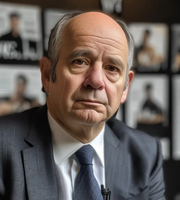The New Investment Imperative: Balancing Risk, Hedging, and the Golden Anchor in a Volatile World
In an era defined by geopolitical tensions, inflationary pressures, and market unpredictability, investors are grappling with how to navigate what Berenberg Bank describes as a “brave new world” of financial uncertainty. The German financial institution’s 2025 investment strategy offers a blueprint for this environment: a disciplined blend of risk mitigation, opportunistic equity exposure, and a strategic embrace of gold as both a diversifier and a hedge. At its core lies a barbell strategy that balances growth and safety, paired with active hedging to protect against systemic shocks.
Ask Aime: What's the best bet for my 2025 investments with the market's wild swings?
The Barbell: Growth and Safety in Tension
Berenberg’s approach hinges on a “barbell” allocation, where 80% of capital is divided between equities (with a focus on undervalued European small caps) and defensive assets—gold, cash, and Bitcoin. This marks a 10-percentage-point increase from 2024, underscoring the firm’s heightened emphasis on balance. The rationale is twofold: to exploit opportunities in regions like Europe, where small-cap equities are historically cheap, while shielding portfolios from downside risks via low-correlation assets.
Ask Aime: "Should I invest in undervalued European small caps for balanced growth and safety amid market volatility?"

The equity portion targets European small caps, which trade at a 20% discount to their historical averages and benefit from a weak euro. Meanwhile, defensive assets like gold and Bitcoin are positioned to offset inflation and geopolitical risks. This structure reflects Berenberg’s belief that markets are in a prolonged period of “ultra-soft landings” in the U.S. and uneven recoveries elsewhere, necessitating flexibility.
Ask Aime: Can I make smart investments in a volatile market?
Hedging: The Quiet Insurance Against Crisis
Central to the strategy is active hedging, primarily through options-based instruments such as put options on liquid equity indices. These hedges are dynamically screened to ensure cost-effectiveness, aiming to limit drawdowns without sacrificing upside potential. For instance, a 10% allocation to put options on the S&P 500 could reduce portfolio volatility by 15-20% during a market crash, according to Berenberg’s stress tests.
The Berenberg Guardian Absolute Return Fund, a flagship vehicle for this strategy, employs three pillars:
1. Interest Income: Short-duration government and investment-grade bonds provide steady returns while maintaining liquidity.
2. Hedging: Put options on equity indices act as a “financial umbrella” during storms.
3. Tactical Opportunities: During crises, profits from hedging instruments are reinvested in undervalued assets, such as equities during sell-offs.
This structure targets a maximum annual drawdown of 20%, a stark contrast to the 30%-plus declines seen in major equity indices during the 2020 pandemic crash.
Gold’s Golden Role: More Than a Safe Haven
Gold is not merely a defensive asset in this framework but a strategic cornerstone. Berenberg highlights geopolitical tensions (e.g., Ukraine, Taiwan), central bank policies (e.g., prolonged high rates in the Eurozone), and macroeconomic uncertainty as tailwinds for gold, which has already risen 12% in 2024. The firm expects further gains, particularly as central banks in China and India continue to diversify reserves away from the dollar.
The Swiss National Bank’s recent warnings about the overvalued franc also underscore gold’s role as a currency-agnostic store of value. While industrial commodities like copper stagnate due to weak Chinese demand, gold’s ascent is driven by structural factors, not fleeting supply-demand imbalances.
UK Equities: A Cautionary Optimism
Berenberg’s outlook for UK equities is cautiously bullish, projecting 10-15% returns in 2025 despite political instability and high inflation. The FTSE 100’s forward P/E ratio of 10.7x—well below its 15x historical average—offers a margin of safety. The strategy emphasizes systematic momentum factors, such as rising earnings per share and dividend yields, paired with “quality at a reasonable price” metrics.
Debunking Misconceptions: Hedging’s Long-Term Value
Critics often dismiss hedging as a drag on returns, but Berenberg’s data challenges this view. While hedging instruments may have negative expected returns in isolation, their inclusion reduces maximum drawdowns, which is critical for long-term compounding. For instance, a portfolio with hedging would have recovered from the 2008 crash in 8 years, versus 13 years for an unhedged portfolio. This resilience helps investors avoid panic selling and stay committed to their strategies.
Conclusion: The Case for Resilience
Berenberg’s 2025 strategy is a masterclass in risk-aware investing. By allocating 80% of capital to a barbell of equities and defensive assets, pairing it with dynamic hedging, and leveraging gold’s unique properties, investors can navigate a world where inflation, geopolitical strife, and currency volatility are the new normal. The Guardian Fund’s 20% drawdown ceiling and its tactical agility—deploying hedging profits to buy dips—provide a template for preserving capital while seeking growth.
The numbers speak for themselves: European small caps offer a 20% valuation discount, UK equities trade at a 35% discount to their 2008 peak, and gold’s correlation to equities has averaged -0.3 over the past decade, making it a potent diversifier. As Berenberg’s analysis reminds us, in a volatile world, balance is not just prudent—it’s essential.
In this brave new world, the investors who thrive will be those who embrace balance, hedge thoughtfully, and anchor their portfolios in the enduring value of gold.


_442a2dcc1749832873286.jpeg)
_e68fac6d1749831664430.jpeg)






